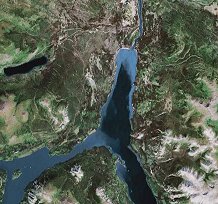
December Editorial

December Editorial
A gem from Tagish Lake in Canada |
|
Many people saw, heard and smelled the 150-ton rock as it plunged from space into the earth's atmosphere and then into Tagish Lake in a remote area of Canada. On its way down to earth the rock created a bright fireball with a long flaming tail. The high sulphur content of the rock caused a very characteristic odour which was commented on by many who witnessed the occasion. Finally the rock hit the frozen surface of Tagish lake breaking up into numerous pieces. Before the impact, the Tagish Lake meteorite was estimated at 4 metres in diameter and 56 tonnes in weight. However, when the fragments of the massive lump of rock were found, only 1.3 tonnes remained, meaning that around 97% of the meteorite had vaporised on its descent, during which the meteor expended around 1.7 kilotons of energy. Of the 1.3 tonnes of fragmented rock, only 0.1% has been discovered and collected. That was on the 18th of January, 2000. Now six years later, studies on this meteorite are still very much in progress, but what has been found out so far is of great importance. It was a pure struck of luck that the meteorite hit the frozen lake and the pieces recovered were still frozen. This gave scientists a unique opportunity to study uncontaminated organic matter preserved in ice. There are many things about this meteorite which make it very special. For a start, it is a so-called carbonaceous chondrite - a primitive, carbon-rich meteorite that contains organic compounds such as amino acids. Unlike most rocks found in the Solar System, it has not been changed by major heating sometime in its history and as such allows us a chance to glimpse the very origin the planets and of the Sun itself. The meteorite is the first example of its kind to be recovered. Analysis of the rock showed the presence of nanodiamons, tiny particles of intrastellar matter which contain material of the original solar nebula (the solar nebula was the cloud of gas and dust that came together to form the Solar System). This, combined with the pattern of oxygen isotopes reported by Professor Lipschutz, confirms that the meterorite was very, very old. At the begining of this month scientists from the Johnson Space Center of NASA reported the presence of hollow spheres in this primordial meteorite. Though empty inside the globules have organic molecules on the outside. Most of the meteorite's material is about the same age as our solar system - approximately 4.5 billion years - meaning that the material and the solar system formed at the same time. But the microscopic organic globules that make up about one-tenth of one per cent of the object appear to be far older.Their chemistry (very unusual hydrogen and nitrogen isotopic compositions) suggest that they formed at -260oC and are not Earth contaminants. In fact, these organic molecules most probably originated in the cold molecular cloud that gave birth to our Solar System. Although scientists cannot be sure, there is a possibility that this type of meteorite has been falling on to our planet throughout the entire history of planet Earth and Earth was seeded with these organic globules at the same time as life was first forming here - although nobody is suggesting that this meteorite contains primitive life forms. The original researchers website contains reports of the original impact and photographs of the fireball. |
| _______________________________ | ||||
| Home | | | Shopping | | | Database |
© Biscuit Software 2004-2015
All rights reserved